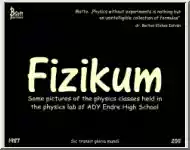Comments
No comments yet. You can be the first!
What did others read after this?
Content extract
Source: http://www.doksinet Spectroscopy techniques [photometry at many wavelengths] Danny Steeghs Source: http://www.doksinet The basic spectrograph slit collimator disperser camera telescope focal plane lens detector Source: http://www.doksinet Spectrographs • Slit aperture – Long and narrow slit ; spatial information along slit – Fibers ; multi-object and integral field – Multiple slitlets ; multi-object spectroscopy • Dispersers – Prisms ; limited to low resolution dq/dl dn/dl ( l-3 for glass ) – Gratings ; reflective/transmissive, holographic – Grisms ; grating on prism interface – Cross-dispersers ; image many orders simultaneously Source: http://www.doksinet Gratings • Grating equation nl = d ( sin b + sin a ) n = order d = groove spacing a,b = angles relative to blaze • Dispersion db/dl = n / ( d cos b ) constant dispersion for given groove spacing and order watch for order overlap nl1 = (n+1)l2 Source: http://www.doksinet
Dispersion, resolution, sampling • The intrinsic resolution of the spectrum is governed by the telescope PSF and the slit aperture – Slit width > PSF ; seeing-limited resolution – Slit width < PSF ; slit-limited resolution – Resolving power; R = l / Dl • The disperser determines the physical dispersion of the light as a function of wavelength • The detector must sample this physical scale accordingly [at least two pixels per resolution element] • E.g The ISIS spectrograph on the 42m WHT 600 groove/mm grating projects to 33Å/mm on detector plane The spatial scale of the detector plane is 14.9”/mm CCD detector has 13.5 micron pixels - maximum resolution at 2-pixels is 0.89Å - this is 0.40” so need a 04” slit to achieve this resolution - the CCD has 4096 pix in the dispersion direction and covers 1822Å - R = Dl/l = 5,618 at 5000Å Source: http://www.doksinet Some real spectrographs ISIS on the WHT RC spectrograph at Kitt Peak Source:
http://www.doksinet The detector view along slit point sources dispersion direction cosmic rays sky background • spectral format CCD ; more pixels in the dispersion direction to sample the spectrum • spatial information along the slit still available Source: http://www.doksinet along slit The detector view ; spatial slice dispersion direction along slit Source: http://www.doksinet along slit The detector view ; spectral slice dispersion direction Source: http://www.doksinet Echelle spectrographs • Uses gratings at very high order (thus high resolution), and uses a 2nd low resolution cross-disperser to separate individual orders individual orders slit coverage MIKE on Magellan • Can reach very high R of few times 104 - 105 • Slit is short to avoid order overlap; limited spatial/sky info Source: http://www.doksinet Integral Field Spectroscopy aka 3D • Long-slit can provide spatial information along the slit, can slice extended objects ; I(x,l) [2D]
• To sample targets in two spatial dimension, a bundle of apertures is needed ; I(x,y,l) [3D] • Each fiber/lenslet in the bundle is then fed into a spectrograph and dispersed Source: http://www.doksinet Integral Field Spectroscopy example IMACS/IFU on Magellan dispersion direction each fiber projects a spectrum I(x,y,l) reconstructed monochromatic image Source: http://www.doksinet Multi-object spectrographs • Multiplex advantage by placing multiple apertures on the field of view and feeding each of these through the spectrograph • Good for wide field-of-view instruments where the density of interesting targets per field is large • Main types – No apertures ; just disperse the FoV + No light-losses in apertures - Spectra/background of distinct sources overlap – Use slitmasks ; cut short slits at position of each target + Get the same advantages as a single slit - Need to make custom slitmask for each pointing - Limited number of slits can be carved before spectra
overlap – Use fibers ; place fiber at each target position + Flexible and can setup fibers on the fly + Can re-image the fibers efficiently onto the CCD ; more objects - Fiber size (=aperture) is fixed, background+target light combined Source: http://www.doksinet Slitless spectroscopy • no slit-losses, but also no control over resolution • confusion / spectral overlap Source: http://www.doksinet MOS slitmasks Image of the FOV Custom slitmask slits at targets dispersed spectra reference stars for pointing Source: http://www.doksinet Fiber MOS example Pick your targets IPHAS star forming region Source: http://www.doksinet MMT HectoSpec Source: http://www.doksinet MMT HectoSpec Source: http://www.doksinet MMT HectoSpec dispersion direction each fiber projects a spectrum I(x,y,l) Source: http://www.doksinet Summary: Apertures • Slit-based spectra – 1D spatial profile – good sky subtraction – adapt slit-width and length to conditions and goals
– Not many targets • Fiber-based spectra – No spatial information over fiber – Sky and target light combined – Sky subtraction relies on sky fibers that may be far away – Limited flexibility in terms of aperture size/geometry – Very flexible for mapping FOV ; MOS/IFU Source: http://www.doksinet Extracting the spectrum We will use the long-slit example as our template, multiplexed configurations whether for multiple orders or multiple objects is in 1st order just multiplexing single object spectral extraction Source: http://www.doksinet Extracting the spectrum signal = (source + background) – background@source S(l) = S I(y,l) p(y) – S I(y,l) b(y) object profile weight sky profile weight D(l) = f(x,y) f(x) relates l to x,y dispersion relation y l Source: http://www.doksinet Sky background • Background has contributions from many sources; – Air glow ; strong discrete emission lines – Zodiacal light ; mV ~ 22.-235 – Sun/Moonlight new moon :
mV ~ 21.9 full moon : mV ~ 19.9 – Aurorae – Light pollution – Thermal emission from sky, telescope and buildings – Non-resolved astronomical background Source: http://www.doksinet Sky background OI 5577 OI 6301 OH air-glow HgI Na Na HgI HPS Source: http://www.doksinet Sky background ; Tucson OI 5577 HgI HgI Na Na OI 6301 Source: http://www.doksinet Atmospheric transmission • Atmospheric transmission is strongly dependent on wavelength Source: http://www.doksinet Telluric absorption Source: http://www.doksinet Telluric absorption Source: http://www.doksinet Summary: Background • The background is a composite of many sources • All of these are dependent on wavelength and their strength varies with time • Some correlate with lunar cycle, airmass, solar activity cycle etc., but many variations are erratic • Background subtraction needs to be done on a wavelength by wavelength basis and ideally is measured simultaneously with the object exposure
• Some parts of the spectrum may be background dominated, others not ; error propagation
Dispersion, resolution, sampling • The intrinsic resolution of the spectrum is governed by the telescope PSF and the slit aperture – Slit width > PSF ; seeing-limited resolution – Slit width < PSF ; slit-limited resolution – Resolving power; R = l / Dl • The disperser determines the physical dispersion of the light as a function of wavelength • The detector must sample this physical scale accordingly [at least two pixels per resolution element] • E.g The ISIS spectrograph on the 42m WHT 600 groove/mm grating projects to 33Å/mm on detector plane The spatial scale of the detector plane is 14.9”/mm CCD detector has 13.5 micron pixels - maximum resolution at 2-pixels is 0.89Å - this is 0.40” so need a 04” slit to achieve this resolution - the CCD has 4096 pix in the dispersion direction and covers 1822Å - R = Dl/l = 5,618 at 5000Å Source: http://www.doksinet Some real spectrographs ISIS on the WHT RC spectrograph at Kitt Peak Source:
http://www.doksinet The detector view along slit point sources dispersion direction cosmic rays sky background • spectral format CCD ; more pixels in the dispersion direction to sample the spectrum • spatial information along the slit still available Source: http://www.doksinet along slit The detector view ; spatial slice dispersion direction along slit Source: http://www.doksinet along slit The detector view ; spectral slice dispersion direction Source: http://www.doksinet Echelle spectrographs • Uses gratings at very high order (thus high resolution), and uses a 2nd low resolution cross-disperser to separate individual orders individual orders slit coverage MIKE on Magellan • Can reach very high R of few times 104 - 105 • Slit is short to avoid order overlap; limited spatial/sky info Source: http://www.doksinet Integral Field Spectroscopy aka 3D • Long-slit can provide spatial information along the slit, can slice extended objects ; I(x,l) [2D]
• To sample targets in two spatial dimension, a bundle of apertures is needed ; I(x,y,l) [3D] • Each fiber/lenslet in the bundle is then fed into a spectrograph and dispersed Source: http://www.doksinet Integral Field Spectroscopy example IMACS/IFU on Magellan dispersion direction each fiber projects a spectrum I(x,y,l) reconstructed monochromatic image Source: http://www.doksinet Multi-object spectrographs • Multiplex advantage by placing multiple apertures on the field of view and feeding each of these through the spectrograph • Good for wide field-of-view instruments where the density of interesting targets per field is large • Main types – No apertures ; just disperse the FoV + No light-losses in apertures - Spectra/background of distinct sources overlap – Use slitmasks ; cut short slits at position of each target + Get the same advantages as a single slit - Need to make custom slitmask for each pointing - Limited number of slits can be carved before spectra
overlap – Use fibers ; place fiber at each target position + Flexible and can setup fibers on the fly + Can re-image the fibers efficiently onto the CCD ; more objects - Fiber size (=aperture) is fixed, background+target light combined Source: http://www.doksinet Slitless spectroscopy • no slit-losses, but also no control over resolution • confusion / spectral overlap Source: http://www.doksinet MOS slitmasks Image of the FOV Custom slitmask slits at targets dispersed spectra reference stars for pointing Source: http://www.doksinet Fiber MOS example Pick your targets IPHAS star forming region Source: http://www.doksinet MMT HectoSpec Source: http://www.doksinet MMT HectoSpec Source: http://www.doksinet MMT HectoSpec dispersion direction each fiber projects a spectrum I(x,y,l) Source: http://www.doksinet Summary: Apertures • Slit-based spectra – 1D spatial profile – good sky subtraction – adapt slit-width and length to conditions and goals
– Not many targets • Fiber-based spectra – No spatial information over fiber – Sky and target light combined – Sky subtraction relies on sky fibers that may be far away – Limited flexibility in terms of aperture size/geometry – Very flexible for mapping FOV ; MOS/IFU Source: http://www.doksinet Extracting the spectrum We will use the long-slit example as our template, multiplexed configurations whether for multiple orders or multiple objects is in 1st order just multiplexing single object spectral extraction Source: http://www.doksinet Extracting the spectrum signal = (source + background) – background@source S(l) = S I(y,l) p(y) – S I(y,l) b(y) object profile weight sky profile weight D(l) = f(x,y) f(x) relates l to x,y dispersion relation y l Source: http://www.doksinet Sky background • Background has contributions from many sources; – Air glow ; strong discrete emission lines – Zodiacal light ; mV ~ 22.-235 – Sun/Moonlight new moon :
mV ~ 21.9 full moon : mV ~ 19.9 – Aurorae – Light pollution – Thermal emission from sky, telescope and buildings – Non-resolved astronomical background Source: http://www.doksinet Sky background OI 5577 OI 6301 OH air-glow HgI Na Na HgI HPS Source: http://www.doksinet Sky background ; Tucson OI 5577 HgI HgI Na Na OI 6301 Source: http://www.doksinet Atmospheric transmission • Atmospheric transmission is strongly dependent on wavelength Source: http://www.doksinet Telluric absorption Source: http://www.doksinet Telluric absorption Source: http://www.doksinet Summary: Background • The background is a composite of many sources • All of these are dependent on wavelength and their strength varies with time • Some correlate with lunar cycle, airmass, solar activity cycle etc., but many variations are erratic • Background subtraction needs to be done on a wavelength by wavelength basis and ideally is measured simultaneously with the object exposure
• Some parts of the spectrum may be background dominated, others not ; error propagation





 When reading, most of us just let a story wash over us, getting lost in the world of the book rather than paying attention to the individual elements of the plot or writing. However, in English class, our teachers ask us to look at the mechanics of the writing.
When reading, most of us just let a story wash over us, getting lost in the world of the book rather than paying attention to the individual elements of the plot or writing. However, in English class, our teachers ask us to look at the mechanics of the writing.